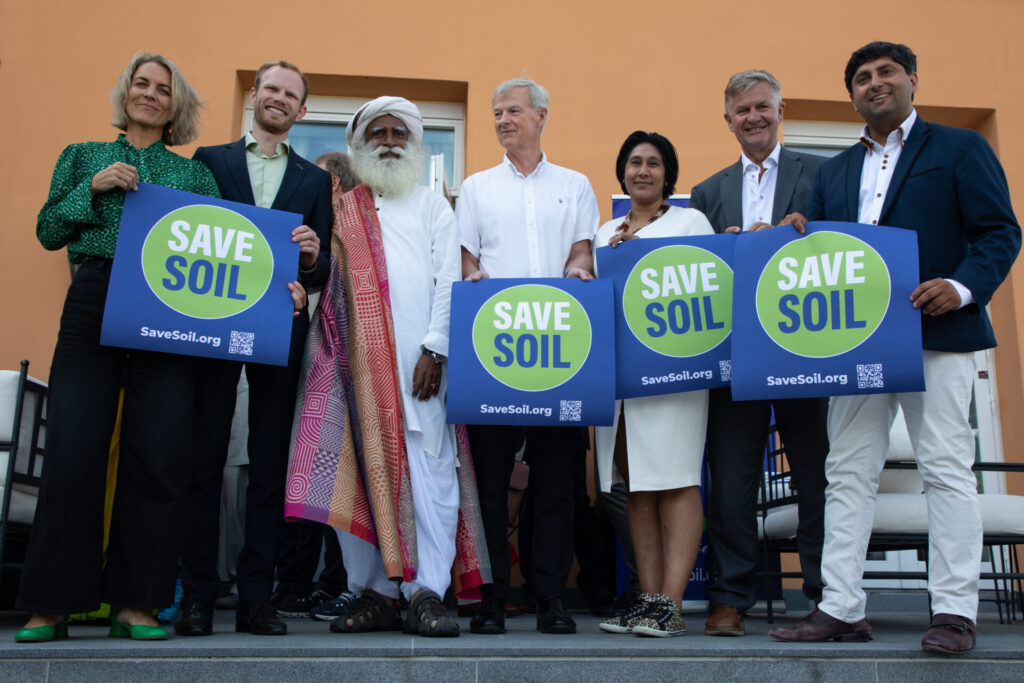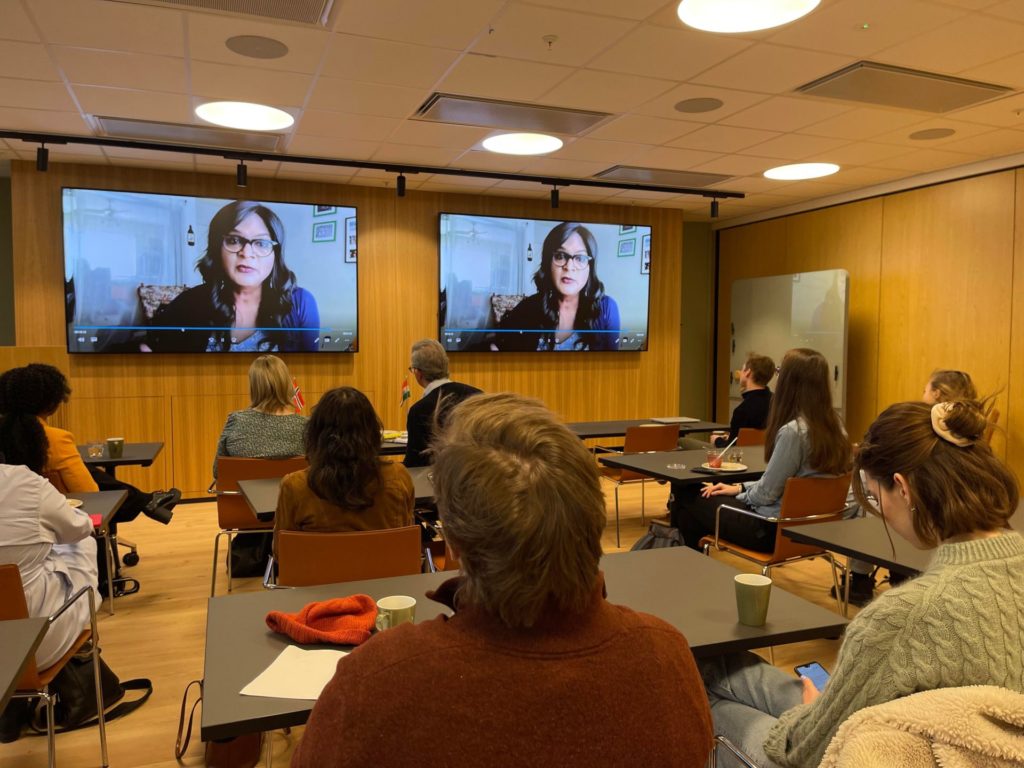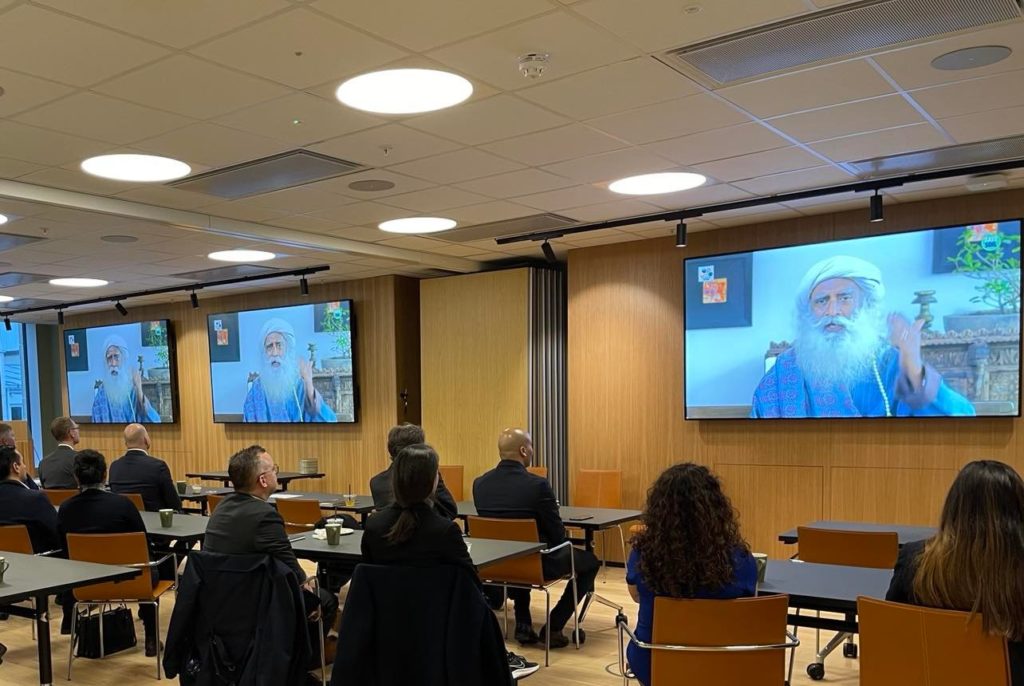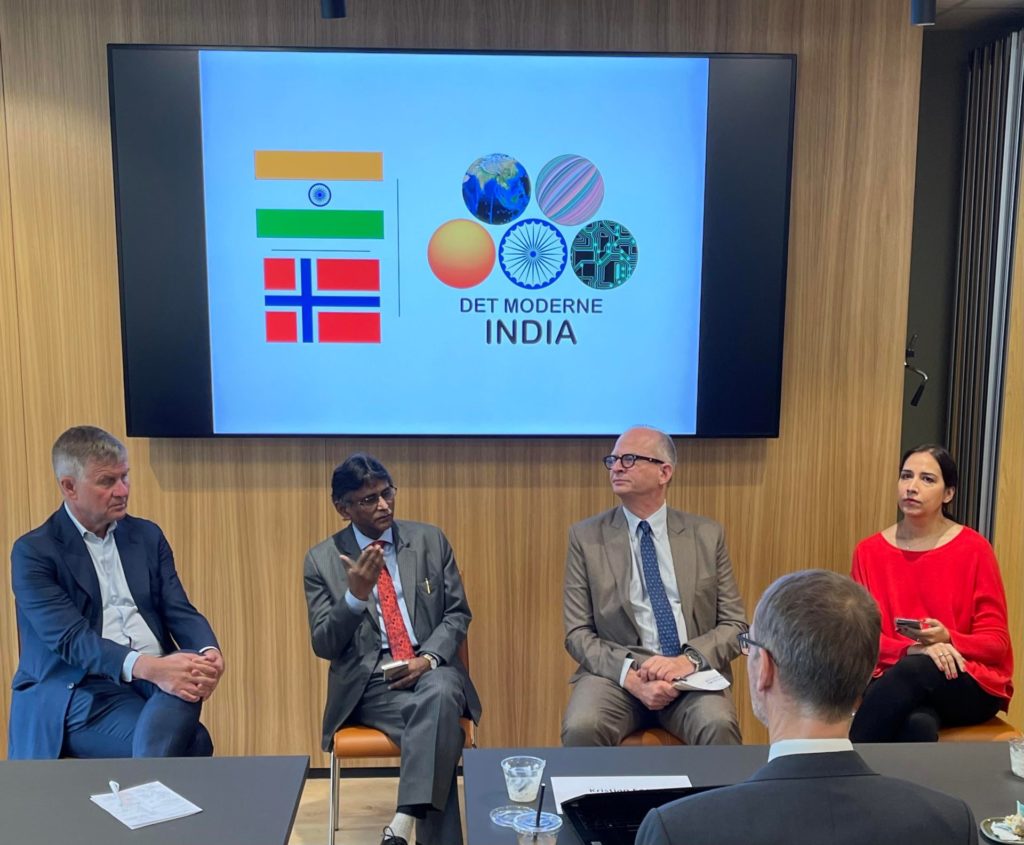The dialogue between Sadhguru and the business executives highlighted the crucial role of conscious leadership in fostering sustainable businesses, nurturing a harmonious society, and advocating for the preservation of our precious soil.



Sadhguru who is ranked among the 50 most influential people in India, is a yogi, mystic, visionary and bestselling author made his first visit to Norway and formed a great engagement on the Save Soil movement.
Soil is an issue that we must attend to now, or we will regret it as a generation. Every scientific study is clearly pointing out that we only have enough soil for another 80 to 100 crops — 45 to 60 years maximum. It is inevitable that in another 30 years' time, there will be a serious food crisis. At the same time, our population will be over 9 billion.
For this event we gathered a diverse group of experts, thought leaders, and passionate individuals who share a common goal: to explore innovative ideas, exchange knowledge, and foster collaboration in our collective mission to save soil. Through the panel discussion we aim to deepen our understanding of the intricate web of life within the soil, its crucial role in supporting food production, mitigating climate change, and maintaining biodiversity.
We are sharing a few glimses below:

In the panel we also have with us Erik Solheim. MP Ola Elvestuen, and the host: MP Himanshu Gulati.


A fully packed hall of politicians, business leaders, ambassadors, pastors and ordinary citizens were inspired by his wisdom and perspectives.

Meeting with Minister of International Development Anne Beathe Tvinnerheim

I mai gikk India forbi Kina som verdens mest folkerike stat, ifølge FN. Med 1,43 milliarder mennesker er India allerede verdens femte største økonomi, og i solid vekst. Økonomisk er vi inne i Indias tiår, mener ledende økonomer.
De geopolitiske utfordringene står imidlertid i kø, og den gjeldende globale orden blir kraftig utfordret. Stater med de største økonomiene vil kreve mer innflytelse.
Registrering, kaffe, mingling og en smak av India kl. 8.30-9.00
Program
Velkommen og presentasjon av dagens innledere
Berit Rian, adm. direktør Næringsforeningen i Trondheimsregionen
Tord Lien, konserndirektør kommunikasjon og samfunn, ANEO
India som vekstmarked
Magdalena Støldal, Senior Advisor International Advisory Team, DNB
Vi kan ikke forstå verden uten å forstå India
Rina Sunder, Det Moderne India
Hvordan jobber vi i India? Gode råd til næringslivet
Elisabeth Strand Vigtel, spesialrådgiver India, Innovasjon Norge
Transitioning from academia to industry in Norway
Nisha Dalal, Machine Learning Engineer, ANEO
Q & A
Frokostmøtet om India er et samarbeid mellom ANEO/TrønderEnergi, DNB, Det Moderne India og Næringsforeningen i Trondheimsregionen. Møtet er en del av Internasjonal dag 1. juni.



We are sharing a few glimpses below:






Save Soil is a global movement launched by Indian spiritual leader Sadhguru
Humanity is facing many issues — economic challenges, lack of inclusion, disparity… Soil is an issue that we must attend to now, or we will regret it as a generation. Every scientific study is clearly pointing out that we have enough soil only for another 80 to 100 crops — 45 to 60 years maximum. In another 30 years’ time, there’s going to be a serious food crisis. That is inevitable, it’s going to happen. At the same time, our population will be over 9 billion.
Soil is a living entity: 87% of life on this planet is lived within the first 12 inches of soil, which is dying at an unimaginable rate, to a point where 80% of the insect biomass is already gone. That happened in the last 30 years. And they’re saying that by the end of the century, more than 50% of the bio-organisms or micro-organisms will be extinct. When that happens, you cannot revive the soil. So, if we act now, in the next 15 to 25 years, we can turn this around. If we act after 50 years, it will take 200 to 500 years to turn this around. To pull back one inch of topsoil normally takes 500 years.
Norway India history in the making!
International Climate Summit 2022 was successfully held in Bergen, Norway. What a summit!
What made this summit unique?
In 2014, during a state visit of the Indian President in Norway, a delegation of 40 Indians took part in the visit. During the International Climate summit 2022, there was more than 50+ delegates from India.
Shri Nitin Gadkari, Hon’ble Minister of Road Transport and Highways of India, attended the International Climate Summit 2022 virtually. He stated that India is focusing on lowering its carbon footprint, cutting energy imports, and using green energy sources. Shri. Nitin Gadkari also praised initiatives and collaborations that will help India realise its potential to become the world’s largest producer of green hydrogen.
CS 2022 was inaugurated with the lighting of the lamp by Gurudev Sri Sri Ravi Shankar, Founder, The Art of Living Foundation, who noted in his address that Norway and India has always stood for two things – environment and peace.
At the same event, Espen Barth Eide, Minister of Climate and Environment, Norway said that the world is facing a climate crisis and there is a greater need for us to go green in every aspect of life. He shared that Norway is aggressive in its pursuit of green hydrogen, a common connection that they share with India. Jan Christain Vestre, Minister of Trade and Industry, Norway, shared that the country is currently scaling up hydrogen production at industrial levels around the world. He added that while the projects undertaken show that Norway can and will push for global development of zero emission solutions, they’ll not do it all alone.
Elisabeth Sæther, State Secretary, the Norwegian Ministry of Petroleum shared her insights in the Ground-breaking projects for scaling the H2value chain.
The five parallel sessions were hosted by:
The International Climate Summit was held for the first time on 3rd of September 2021 in New Delhi. The summit was organized by PHD Chamber of Commerce and Industry in association with Invest India and Innovation Norway as the Country Partner. The participation was overwhelming, including a high level delegation from Norway along with 35,000 participants from around the globe. Several Nobel laureates, Academicians, Policy Makers worldwide attended the summit.
Day 2 – Industry Visits – Get to know how the hydrogen businesses and projects around Bergen are enabling the green transition
About 1 hour from Bergen, at Kollsnes we find the Coast Center Base (CCB) Energy Park. There, ZEG Power is constructing a pilot demonstration plant for blue hydrogen production, and Northern Lights is developing the world’s first open-source CO2 transport and storage infrastructure. After the visit and lunch, the return to Bergen City will be enriched with stops at the EV fast-charging location operated by Greenstation.
The day ends at Fantoft with presentations from companies offering innovative solutions or technologies.
Organisers: PHD Chamber | Invest India | The Norwegian Hydrogen Cluster | Norsk Hydrogenforum | The Modern India
Sponsored by: Greenstat | Alma Clean Power
Millions have watched Pose on HBO. In India, people don’t watch! Government acts! While recognition of genders outside of male and female has only recently been discussed in Western societies, in the Indian society, people of non-binary gender expressions have played important roles for over 2000 years.
India's Supreme Court has ruled that transgender people are created as a third gender in the country. The decision is seen as a milestone in India. This was the first time in world history that a Supreme Court recognizes transgender people as a separate gender.
Diversity campaigns and Pride flagging notwithstanding: Research indicates that it is difficult to be a trans person in working environments. According to the report "Sexual orientation, gender diversity and living conditions" from 2021, transgender people stand out in terms of mental health, life satisfaction and experiences of discrimination. Transgender rights matters!
We are excited to share that we will have Celia Sandhya Daniels, Miriam Hardarson and Kanta Singh, Deputy Country Representative - UN Women, India as three of our speakers.
The seminar will be moderated by Chisom Udeze, founder of Diversify and Her space.
Join us for an engaging debate on DEIB on Wednesday, March 30th @ 8:00-10:30am* Universitetsgata 9, Bull & Co.

A few glimpses from the event:




Women will drive India´s future as India now officially has more females than males. In Norway, many high profile leaders have joined the Norwegian campaign #arnekampanjen.
The information campaign is inspired by a Dutch LinkedIn campaign called Peter. There are more leaders in the Netherlands named Peter than there are female leaders in total.
As DEIB is in the core of DMI, we have decided to support #arnekampanjen.
Our guests for this conversation are:

Sindre Finnes is the husband of Erna Solberg. Erna was the PM for 8 years. He is a Norwegian economist and organizational leader in Norwegian Industry.
Christian Lund is the husband of Kristin Skogen Lund. Kristin is the CEO of Schibsted Media Group. Kristin Skogen Lund has been ranked as Norway's most powerful woman many times. He is a federal an appeal court judge in Oslo .
Parul Soni is Founder of Association of Business Women in Commerce & Industry (ABWCI). Its membership spans across some of the most prominent Women entrepreneurs, Women organisations, Educational institutions, and Companies investing in Women.
Rina Sunder is the founder of Det Moderne India. She regular commentator and speaker on India, the rise of Asia, innovation, sustainability and global trends in leading Norwegian media and academia.
This was a by invitation only conversation. The podcast will be released on March 8th.

India is a multi-religious, multi-lingual, multi-racial, multi-cultural country. Its secular status is, however, a heated topic for debate today.
India has a long and mostly honorable tradition of using soft power in its diplomacy. Religion plays a very central and definitive role in Indian society and culture. It can often be seen to influence businesses and the economy.
Guest of honor: Sadhguru

Join us for an engaging debate on secularism and doing business in India on Tuesday, March 1, 2022 at 8:00-11:30am.

Itinerary*:
| Time | Topic | Speaker |
|---|---|---|
| 08:00-08:30 | Mingling and breakfast | |
| 08:30-08:35 | Welcome | Hans Geelmuyden, Chair DMI |
| 08:35-08:50 | Guest of honor | Sadhguru |
| 08:50-09:10 | India today | Norway’s ambassador to India, Hans Jacob Frydenlund |
| 09:10-09:20 | India’s religious soft power strategies | Ambassador Bala Bahskar |
| 09:20-09:30 | Clash of Civilizations’ when doing business | Rina Sunder, founder, and author, DMI |
| 09:30-09:40 | Meeting religion in Indian business | Atle Vidar Nagel Johansen, EVP & CEO Orkla Foods |
| 09:45-10:00 | Pause | |
| 10:00-10:45 | Panel Discussion held by Erik Solheim. | Panelists: Ambassador Bala Bhaskar, Op-ed columnist at VG, Shazia Majid |
| 10:45-11:30 | Mingling | |
| 11:30 | END |
*There might be changes in the program.
This is a by invitation only event. If you are interested, please sign up.
A few glimpses from the event:







India now officially has more females than males. There has been a demographic shift.
According to latest data released by the Indian government from the National Family Health Survey (NFHS), there are now 1,020 women for every 1,000 men. Women’s economic empowerment is highly connected to poverty reduction because women tend to invest their earnings into their communities and family’s development. According to World Bank estimates, India’s women in workforce contribute 17% to GDP, which is less than half the global average.
Norway was the first country in the world to put a 40% gender quota on boards of listed companies and public enterprises. Plan International is a development and humanitarian organisation that works to advance children’s rights and equality for girls. The Association of Business Women in Commerce & Industry (ABWCI), on the other hand, is an integrated platform dedicated to the economic empowerment of women in business.
DMI would like to present to you the panelists for our new seminar, which will take place on January 25th.
Isabelle Ringnes is the co-founder of Equalitycheck.com
Parul Soni is founder of Association of Business Women in Commerce & Industry (ABWCI)
Kari Helene Partapuoli is General Secretary, Plan Norway
Rina Sunder is Founder of DMI

The conversation will be moderated by Stig Traavik and Rina Sunder. Traavik is Director of Climate, Energy & Environment at Norwegian Agency for Development Cooperation.
A few of the questions we will touch upon are:
Simply put — women are the key to unlocking the full potential of Indias economy and society. It’s critical that we pave pathways that allow women to soar. DMI are happy to collaborate with Norad on this seminar.
Please join us to discuss how women in India will shape Indias future.
